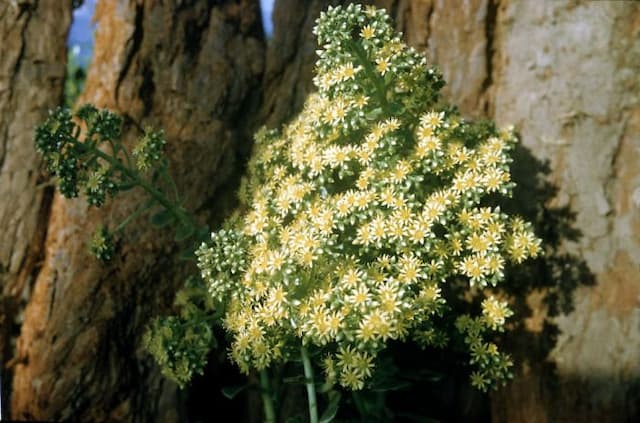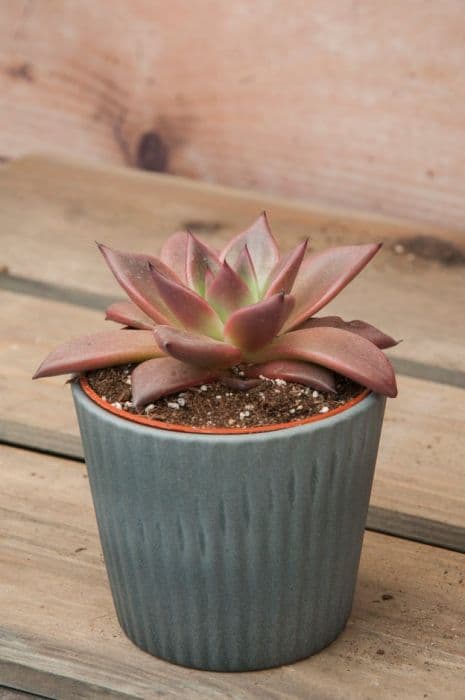Baby burro's tail Sedum burrito

ABOUT
S. burrito is an evergreen succulent with trailing stems to 30cm or more, closely packed with fat, fleshy, blue-green leaves. Small, star-shaped, pink flowers are produced at the tips of the stems in summer
About this plant
 Names
NamesFamily
Crassulaceae
Synonyms
Burro's Tail, Donkey Tail, Lamb's Tail, Horse's Tail
Common names
Sedum burrito, Sedum morganianum 'Burrito'.
 Characteristics
CharacteristicsLife cycle
Perennials
Foliage type
Evergreen
Color of leaves
Green
Height
1 foot [30 cm]
Spread
2 feet [60 cm]
Plant type
Succulent
Hardiness zones
9
Native area
Mexico
Benefits
 General Benefits
General Benefits- Easy to Care For: Sedum burrito, also known as Burro's Tail, requires minimal watering and can thrive with neglect, making it ideal for busy or forgetful owners.
- Drought Tolerant: It's highly drought-resistant, making it perfect for arid climates and water-conscious gardeners.
- Aesthetic Appeal: With its trailing stems and plump, green leaves, Burro's Tail adds a unique visual interest to any indoor or outdoor setting.
- Ideal for Hanging Baskets: Its cascading nature makes it an excellent choice for hanging baskets or elevated planters.
- Propagation: Burro's Tail is easily propagated from leaves or stem cuttings, allowing for easy sharing and multiplying of your plant collection.
- Pest Resistant: It's relatively resistant to pests, reducing the need for chemical insecticides.
- Long Lifespan: With proper care, this succulent can live for many years, providing long-term enjoyment.
- Seasonal Dynamics: The plant may bloom in the summer, offering small, interesting flowers that add to its decorative quality.
- Versatility in Landscaping: Sedum burrito can be used in rock gardens, as ground cover, or in xeriscape designs due to its adaptability to various outdoor conditions.
- Non-Toxic: It's safe for households with pets and children as it is not known to be toxic when ingested.
 Medical Properties
Medical PropertiesThis plant is not used for medical purposes.
 Air-purifying Qualities
Air-purifying QualitiesThis plant is not specifically known for air purifying qualities.
 Other Uses
Other Uses- Sedum burrito, often known as "Burro's Tail," can be used in living wreaths due to its draping nature, which adds a unique green cascade to the design and complements other succulents.
- The thick, fleshy leaves of Burro's Tail can sometimes be used in small-scale landscaping, particularly in fairy gardens, giving a whimsical, trailing effect that mimics larger-scale plants.
- In container gardens, Burro's Tail serves as a "spiller," gracefully overflowing the edges of pots and adding texture to the container's plant composition.
- Hung in macrame plant holders, Burro's Tail brings a retro, bohemian charm to interior spaces and can be a central part of boho-chic decor.
- The plant can be used in terrariums, although its fast growth may require regular maintenance to keep it from outgrowing the space.
- As part of a green roof planting scheme, Burro's Tail's drought tolerance makes it suitable for creating a low-maintenance, succulent-based cover.
- For educational purposes, Burro's Tail provides an excellent example of vegetative propagation, as its leaves easily break off and can root to form new plants.
- Grown as a ground cover in frost-free climates, it can provide erosion control on slopes due to its spreading and rooting habit.
- In hanging baskets, Burro's Tail's trailing stems can grow quite long, making a dramatic visual statement in vertical spaces both indoors and outdoors.
- For texture contrast in mixed succulent dish gardens, the fine, rounded leaves of Burro's Tail juxtapose nicely with the more sculptural forms of other succulents.
Interesting Facts
 Feng Shui
Feng ShuiThe Burro's Tail is not used in Feng Shui practice.
 Zodiac Sign Compitability
Zodiac Sign CompitabilityThe Burro's Tail is not used in astrology practice.
 Plant Symbolism
Plant Symbolism- Endurance: This plant is known for its hardiness and ability to survive in tough conditions, symbolizing the ability to endure and persist through challenges.
- Resilience: Sedum burrito, also known as Burro's Tail, has plump, overlapping leaves that store water, representing resilience and the capacity to bounce back from adversity.
- Peace: With its cool, green hues and cascading growth, it often symbolizes tranquility and a peaceful environment.
- Patience: The Burro's Tail grows slowly and steadily, symbolizing patience and the reward of waiting for things to develop naturally over time.
- Prosperity: In some cultures, succulents are believed to bring good fortune and wealth because of their lush and evergreen appearance, which is often associated with abundance.
 Water
WaterThe Burro's Tail, or Sedum burrito, prefers a thorough watering when the soil has completely dried. Depending on the climate and environment, this might mean watering approximately every two weeks; however, during winter, the plant requires less frequent watering, possibly once a month. Use enough water until it runs out of the bottom of the pot, which could be around 8-16 ounces depending on the size of the pot and the plant. Ensure the plant is not left sitting in standing water to prevent root rot. Adjust watering frequency based on the season and the humidity levels present in the environment.
 Light
LightThe Burro's Tail thrives best in bright indirect light and can tolerate direct sunlight, but it should be acclimated slowly to prevent sunburn. A spot near a south-facing or east-facing window covered by a sheer curtain can provide the right amount of light. Be cautious of too much intense direct sun in summer that could damage the foliage, and if grown indoors, rotate the plant regularly to ensure even light distribution.
 Temperature
TemperatureThe ideal temperature range for the Burro's Tail is between 65 and 75 degrees Fahrenheit. It can survive minimum temperatures of around 40 degrees Fahrenheit but should be protected from frost. During hot summer months, this succulent appreciates cooler night temperatures, which mimic its natural habitat.
 Pruning
PruningPruning the Burro's Tail is primarily done to remove dead or damaged foliage and to maintain its shape. Trim the plant sparingly as needed, typically no more than once a year. The best time for pruning is in the spring when the plant is entering a period of active growth, which allows it to recover more quickly from the stress of pruning.
 Cleaning
CleaningAs needed
 Soil
SoilThe best soil mix for Burro's Tail, commonly known as Sedum burrito, should be well-draining and sandy, ideally a cactus or succulent mix. The soil pH should be slightly acidic to neutral, ranging from 6.0 to 7.5. You can create an ideal mix using half potting soil and half perlite or pumice to ensure proper drainage.
 Repotting
RepottingBurro's Tail, or Sedum burrito, should be repotted every 2 to 3 years, as it is a relatively slow grower. It is best to repot during spring or early summer when the plant is actively growing. However, take care while repotting as the delicate leaves may easily detach from the stems.
 Humidity & Misting
Humidity & MistingBurro's Tail, known as Sedum burrito, prefers low to average humidity levels, making it well-suited for typical indoor environments. Aim for humidity levels between 40% and 60%, avoiding overly humid conditions which could promote rot.
 Suitable locations
Suitable locationsIndoor
Place Burro's Tail near a sunny window; water moderately.
Outdoor
Grow in bright shade or morning sun; protect from hot afternoon sun.
Hardiness zone
9-11 USDA.
 Life cycle
Life cycleSedum burrito, commonly known as Burro's Tail or Donkey Tail, begins its life cycle when seeds are sown in well-draining soil and germinate, which can be a slow process. Once germinated, seedlings will slowly develop fleshy, pea-shaped leaves and start to form trailing stems that can grow very long. The plant enters a vegetative growth phase, during which it focuses on leaf and stem development, storing water and nutrients within its succulent leaves. Throughout its life, Burro's Tail can propagate vegetatively through leaf cuttings or broken stem segments, which readily root and form new plants. After several years, mature plants may produce small, star-shaped flowers in hues of red, pink, or lavender during the summer. The plant's life cycle can continue for many years as it grows and proliferates, given proper care and conditions.
 Propogation
PropogationPropogation time
Spring-Early Summer
Propogation: Sedum burrito, commonly known as "Burrito sedum" or "Donkey Tail," is best propagated during the spring or summer as the warmer temperatures assist in quicker root development. The most popular method is leaf propagation which involves gently twisting a leaf from the stem, ensuring that it's a clean pull without leaving any part on the stem. It's crucial to let the leaf dry for a day or two until the cut end forms a callous to prevent rotting when planted. Once calloused, the leaf is placed on top of well-draining soil and lightly misted with water every few days. Roots and a new plant will emerge from the end of the leaf in a few weeks. During this time, they require bright, indirect sunlight and should be kept at a consistent temperature to facilitate growth.









